Overview of the Global Anemia Problem, Including Iron Deficiency Anemia
The World Health Organization (WHO) defines anemia among women of childbearing age as the condition of having a hemoglobin concentration of < 12.0 g/dL at sea level; among pregnant women it is defined as < 11.0 g/dL. The hemoglobin concentration cutoff level that defines anemia varies by age, gender, physiological status, smoking status, and the altitude at which the assessed population lives.
The primary cause of anemia is iron deficiency, a condition caused by inadequate intake or low absorption of iron, the increased demands of repeated pregnancies—particularly if not well spaced (e.g., fewer than 36 months between pregnancies)—and loss of iron through menstruation. Other causes of anemia include vitamin deficiencies (such as a deficiency of folic acid or vitamin A), genetic disorders, malaria, parasitic infections, HIV, tuberculosis, common infections, and other inflammatory conditions. While iron deficiency anemia (IDA) accounts for about onehalf of all anemia cases, it often coexists with these other causes.
Iron deficiency anemia is most common during pregnancy and in infancy, when physiological iron requirements are the highest and the amount of iron absorbed from the diet is not sufficient to meet many individuals’ requirements (Stoltzfus and Dreyfuss 1998). Anemia’s effects include increased risk of premature delivery, increased risk of maternal and child mortality, negative impacts on the cognitive and physical development of children, and reduced physical stamina and productivity of people of all ages (Horton and Ross 2003). Globally, IDA annually contributes to over 100,000 maternal deaths (22 percent of all maternal deaths) and over 600,000 perinatal deaths (Stoltzfus, Mullany, and Black 2004). Key anemia control interventions include promoting a diversified diet, iron-folic acid (IFA) supplementation during pregnancy, iron fortification of staple foods, prevention and treatment of malaria, use of insecticide-treated bed nets, helminth prevention and control, delayed cord clamping, and increased birth spacing.
Maternal Anemia in Niger
The prevalence of anemia among pregnant women in Niger is 61 percent, making it a severe public health problem as defined by WHO standards1 (INS and Macro International 2007). In terms of anemia severity, the majority of cases among pregnant and breastfeeding or non-pregnant women reported in the 2006 Niger Demographic and Health Survey (NDHS) are classified as mild or moderate.2 Only 2.7 percent of anemia cases in pregnant women and roughly one percent of those in breastfeeding and non-pregnant women are diagnosed as severe. Anemia and iron deficiency during pregnancy may also impact the iron stores of newborns. In a study conducted at a mother-and-child health center in Niamey, children of mothers who received iron supplementation during pregnancy had significantly higher serum ferritin concentrations—a marker used to estimate iron stores—at three and six months of age than children of mothers who were not in the intervention group (Preziosi et al. 1997).
Falter Points in Women's Consumption of Iron-Folic Acid During Pregnancy
WHO recommends that all pregnant women receive a standard dose of 30–60 mg iron and 400 μg folic acid beginning as soon as possible during gestation (WHO 2012). Ideally, women should receive iron-containing supplements no later than the first trimester of pregnancy, which means ideally taking 180 tablets before delivery. It is important to note, that many countries aim for women to receive 90 or more tablets during pregnancy.
Figure 1 shows a decision-tree analysis of how well the Nigerien antenatal care (ANC) system distributes IFA, and identifies four potential points at which the system might falter (highlighted in orange).
Figure 1. Analysis of Falter Points Related to Distribution and Consumption of IFA through Niger’s ANC Program in 2011, Women of Reproductive Age (15–49 Years) n = 9,223
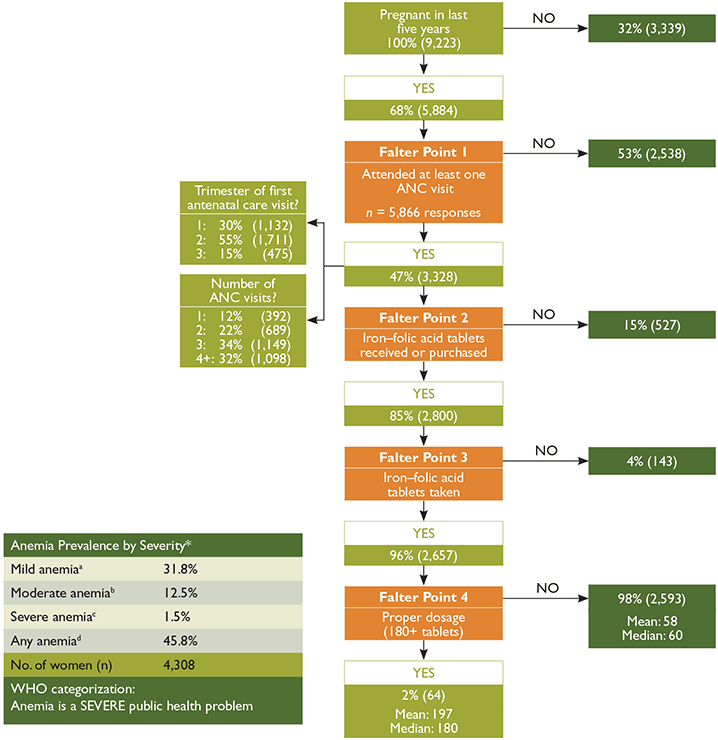
Main Conclusions: Given low coverage rates, ANC is currently an underutilized platform for distributing IFA in Niger. Among women who were pregnant in the last five years, had at least one ANC visit, and took at least one IFA tablet, only two percent received and took the ideal minimum number of tablets. Overall, the most important shortcomings are Falter Points 1 and 4. Supply and demand side considerations need to be investigated.
*Percent of women 15–49 based on Hemoglobin levels Hb (g/dL)
aNPW 11.0≤Hb≤11.9, PW 10≤Hb≤10.9 bNPW 7.0≤Hb≤9.9, PW 7.0≤Hb≤9.9 cNPW Hb<7.0, PW Hb<7.0 dNPW Hb<12.0, PW Hb<11.0
Non-responses, no data were recorded to “No” for “At least one ANC visit?”, “IFA tablets received?” and “IFA tablets taken?” and to zero for “Number of tablets taken?”
Anemia prevalence data are provided as a reference point, signaling the general order of magnitude of the anemia public health problem. The ANC utilization data is based on self-reported data of women 15–49 years in permanent unions and pertains to their last pregnancy in the last five years prior to the DHS survey.
Source: Calculations and anemia levels are from the Niger Demographic and Health Survey (2006).
The figure tracks the number and percentage of women who obtained ANC, those who subsequently received and consumed at least one IFA tablet, and those who consumed the ideal minimum number of tablets.3 All data are based on NDHS questions asked of women who were in permanent unions and had been pregnant in the five years prior to being interviewed4 (INS and Macro International 2007).
Many supply-side aspects—including both adequacy of IFA tablet supplies and technical knowledge and practices of ANC providers—need to be considered when assessing how well an ANC program delivers IFA. In addition, as Falter Point 4 in Figure 1 clearly shows, the provision of IFA tablets to a pregnant woman is a necessary but not sufficient condition for the woman to consume the tablets, particularly at the ideal minimum level. Thus, demand-side factors also play a critical role in determining the coverage and effectiveness of a program. These include whether or not women seek ANC and the timing and number of visits, as well as the extent to which women are aware of the significance of anemia and IFA, ask for IFA tablets, and comply with the IFA regimen.
Understanding the relative significance of each falter point makes it possible to prioritize them for more in-depth analysis, providing a first step in an evidence-based approach to systematically improving the program. The DHS does not collect information on the number of IFA tablets received by women. In the case of Falter Point 4, this lack of data creates ambiguities that make it impossible to fully understand whether shortcomings of the system relate primarily to supply- or demand-side factors. Despite this limitation, the decision-tree analysis presented in Figure 1 still enables prioritizing the falter points for more in-depth analysis and action at the national, district, and health center levels.
Analysis of Falter Points
Falter Point 1:
Did not attend at least one ANC visit
Fifty-three percent of women did not have at least one ANC visit.
ANC’s relatively low coverage undercuts its potential as a vehicle for providing IFA.
Falter Point 2:
Did not receive or purchase at least one IFA tablet
Of the women who had at least one ANC visit, 15 percent did not receive or purchase any IFA tablets.
This supply-side constraint may be due to various system/supply-side performance shortcomings, which could reflect: (1) inadequate supply (e.g., stockouts); (2) inadequate provider knowledge; or (3) inadequate provider practices, whereby IFA may not have been provided.
Unfortunately, the NDHS does not report the source(s) of the IFA tablets women received or purchased, and a small percentage of women attending ANC get IFA tablets from a different source. While 12 percent of Nigerien women who received or purchased IFA did not have any ANC visits (not shown), we cannot ascertain whether or not those who received ANC obtained their IFA from their ANC provider. However, women who attend ANC may be more likely to be aware of, to value, and also to take IFA tablets, regardless of where they obtain them. Thus, we would expect a high correlation between the number of women who had at least one ANC visit and those who received or purchased IFA, which is consistent with the data. Women who had one or more ANC visits and who did not receive any IFA represent a missed opportunity to reduce the risk of anemia among a high-risk population.
Falter Point 3:
Did not take at least one IFA tablet
Of the women who received IFA, four percent did not consume any tablets.
This demand-side constraint is relatively small and may be due to women not understanding the significance of anemia and/or the significance of IFA.
This misunderstanding may reflect: (1) inadequate provider counseling and follow-up; (2) women’s beliefs about actual or possible side effects; or (3) sociocultural factors.
Falter Point 4:
Did not consume 180 or more IFA tablets
Of the women who received and took IFA, 98 percent did not consume the ideal minimum of 180 tablets.
This constraint results from a combination of supply- and/ or demand-side factors. Figure 1 suggests two situations that may contribute to this falter point: 70 percent of women who received ANC began their care after the first trimester, and the 68 percent who had fewer than WHO’s recommended four ANC visits during their last pregnancy may have started their ANC too late or may not have had enough visits to receive 180 tablets (given IFA distribution protocols). Both of these scenarios are likely contributors, but further research is needed to establish their relative importance, as well as the significance of other possible causes.
Globally, research has found that the following situations often contribute to Falter Point 4: (1) providers do not have access to adequate supply; (2) women do not receive adequate tablets because they have little access to care, start ANC late, or do not have enough ANC visits, making it difficult to obtain 180 tablets (given IFA distribution protocols); (3) providers do not provide adequate counseling or follow-up; (4) women do not adhere to the regimen, which may be due to difficulty in remembering to take the tablets daily, not knowing all the tablets are necessary, fear of having a big baby, side effects, or tablet-related issues (taste, size, color, coating, packaging/storage problem). Further research is needed to determine the underlying factors contributing to this falter point in Niger.
Analysis by Sociodemographic Variables and Trends over Time
A comparison of NDHS data from 1998 and 2006 reveals that Niger has made impressive progress in improving IFA coverage (defined as the percentage of women, among all women who were pregnant in the past five years, who received and took at least one IFA tablet). Over the eightyear period, IFA coverage more than tripled, from 11 percent to 45 percent. ANC coverage, on the other hand, improved more modestly, from 40 percent to 47 percent. While these upward trends are encouraging, coverage rates, particularly with respect to ANC, are low compared with other lowand middle-income countries (LMICs). As seen in Table 1, disaggregating IFA and ANC coverage by region, residence area, and wealth allows us to observe variations in coverage and possible inadequate access to care among subgroups of women. Variations by region are substantial. Only 27 percent of women in the Zinder region received ANC, compared with 72 percent of women in Agadez. These two regions are also the two most extreme cases with respect to IFA coverage. Zinder has the lowest IFA coverage, at 34 percent, and Agadez has the highest coverage at 64 percent. By both of these coverage measures, Maradi is also a poor-performing outlier, not far ahead of Zinder. Considerable gaps also exist among women in different residence areas. In the capital district of Niamey, 94 percent and 79 percent of women are receiving ANC and IFA, respectively, well above the national averages. The difference in coverage between urban and rural women is 49 percentage points for ANC and 34 percentage points for IFA. Women in the highest 40 percent in wealth are more likely to receive ANC and IFA than their counterparts in the lowest 40 percent in wealth, by 27 and 23 percentage points, respectively.
Table 1. ANC and IFA Coverage During Last Pregnancy in the Last Five Years by Region, Residence Area, and Wealth, Niger, 2006
| Characteristic | No. Women with a Live Birth - Last 5 Years | Received ANC | Took 1 + IFA Tablet | ||
|---|---|---|---|---|---|
| Number | Percent | Number | Percent | ||
| Region | |||||
| Residence | |||||
| Wealth | |||||
| Agadez | 137 | 98 | 71.5% | 87 | 63.7% |
| Diffa | 146 | 75 | 51.4% | 64 | 43.8% |
| Dosso | 864 | 534 | 61.8% | 540 | 62.5% |
| Maradi | 1,372 | 466 | 34.0% | 473 | 34.5% |
| Tahoua | 1,293 | 607 | 46.9% | 553 | 42.8% |
| Tillabéri | 888 | 474 | 53.4% | 414 | 46.6% |
| Zinder | 1,205 | 329 | 27.3% | 412 | 34.2% |
| Niamey | 396 | 371 | 93.7% | 311 | 78.6% |
| Other Cities | 578 | 487 | 84.3% | 404 | 69.9% |
| Urban Complex | 975 | 858 | 88.0% | 717 | 73.5% |
| Rural | 5,326 | 2,096 | 39.4% | 2,141 | 40.2% |
| Lowest 40% | 2,565 | 926 | 36.1% | 957 | 37.3% |
| Highest 40% | 2,491 | 1,564 | 62.8% | 1,490 | 59.8% |
| National Average | 6,301 | 2,954 | 46.9% | 2,854 | 45.3% |
Table 2 highlights two key ANC indicators in Niger: the number of ANC visits and the timing of the first visit. While there was an overall increase in ANC coverage between 1998 and 2006, only 33 percent of women had their first ANC visit within the first two trimesters of pregnancy in 2006 and only 15 percent of women had the WHO-recommended four or more ANC visits. Improving the percentage of women receiving ANC early in and throughout pregnancy has the potential to increase the percentage of women taking the ideal minimum of 180 IFA tablets (addressing Falter Point 4) and reduce the nationwide prevalence of anemia.
Table 2. Number and Timing of ANC Visits, Niger, 1998 and 2006
| Indicator | 1998 | 2006 | Change in Coverage | Percentage Change |
|---|---|---|---|---|
| Number of ANC Visits | ||||
| Month of First Visit | ||||
| 0 | 60.0% | 52.9% | -7.1% | -11.8% |
| 1 | 4.7% | 5.5% | 0.8% | 17.0% |
| 2-3 | 23.3% | 26.6% | 3.3% | 14.2% |
| 4 + | 11.4% | 14.9% | 3.5% | 30.7% |
| Don't Know/No Data | 0.5% | 0.2% | -0.3% | -60.0% |
| No ANC | 60.0% | 52.9% | -7.1% | -11.8% |
| < 6 | 29.9% | 32.8% | 2.9% | 9.7% |
| 6-7 | 7.9% | 12.2% | 4.3% | 54.4% |
| 8 + | 1.5% | 1.9% | 0.4% | 26.7% |
| Don't Know/No Data | 0.6% | 0.2% | -0.4% | -66.7% |
Analysis by Geographic Region
The map in Figure 2 shows the variation by region in the percentage of women who had at least one ANC visit and received at least one IFA tablet in 2006. With rates ranging from 74 percent to 90 percent, the variation between regions is relatively small and IFA coverage is high among women attending ANC, compared with other LMICs. Given the high IFA coverage among women who received ANC, an expansion of ANC may help improve access to IFA, addressing the missed opportunity for more women to achieve a minimum 180-tablet regimen during their pregnancy. Initial efforts should target Zinder and Maradi, which are by far the poorest-performing regions in terms of both ANC coverage and the percentage of all women with a live birth in the last five years who received and took at least one IFA tablet (Table 1).
Figure 2. Percentage of Women Who Had at Least One ANC Visit and Received at Least One IFA Tablet by Region, Niger, 2006
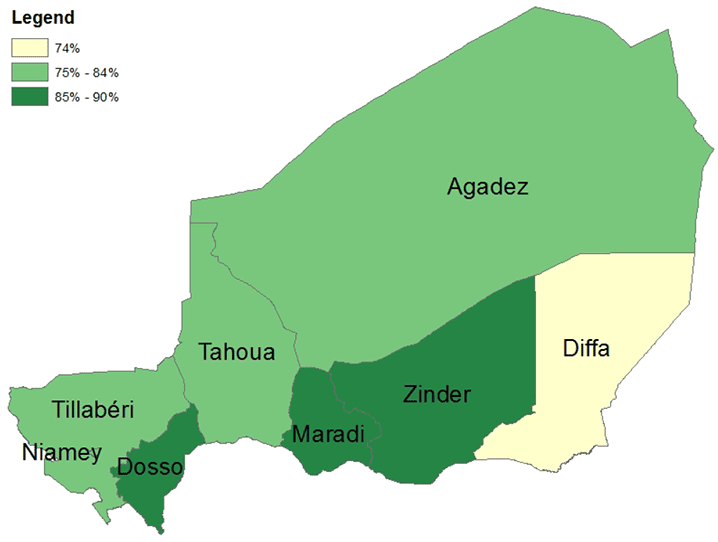
Rates of anemia among women of childbearing age also have inter-regional variations, as seen in Figure 3. The highest rates of severe anemia and anemia of any level occur in the Zinder region, which also has the lowest ANC and IFA coverage. In the capital district of Niamey, the region with the highest ANC and IFA coverage, the prevalence of anemia is lowest.
Figure 3. Prevalence of Anemia Among Women 15–49 Years by Region, Niger, 2006
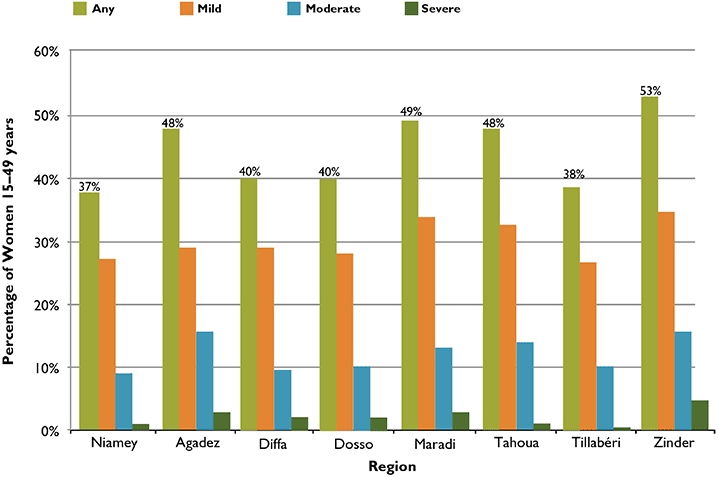
Analysis by Number of ANC Visits
Figure 4 shows the relationship between the number of IFA tablets taken by women who had at least one ANC visit and the number of ANC visits they had during their last pregnancy. Fifty-three percent of the women who had at least one ANC visit took at most one-quarter (45) of the ideal minimum number of IFA tablets. Although women with more visits were generally likely to receive and take more IFA tablets, the relationship is weak. Additional ANC visits usually, but not always, result in a modest increase in the number of IFA tablets consumed. Only three percent of women with four or more ANC visits received and took at least 180 IFA tablets. Learning what accounts for this ceiling is a critical challenge to improving the effectiveness of the ANC-based distribution of IFA in Niger.
Figure 4. ANC Distribution of IFA Tablets: Number of Tablets Received and Taken According to Number of ANC Visits, Niger, 2006
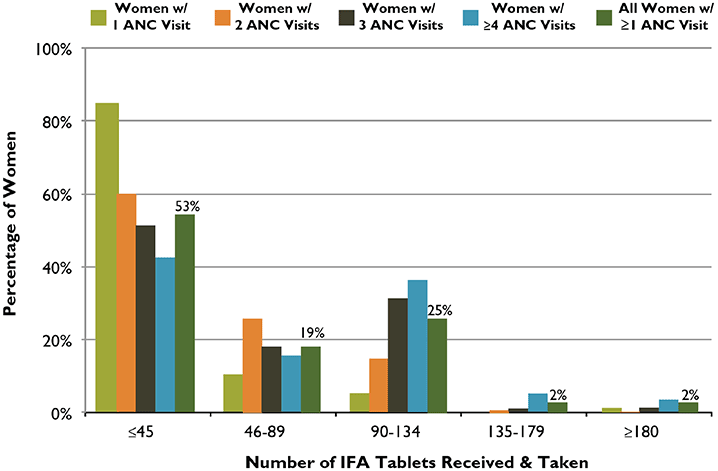
Overall Conclusions and Recommendations
Figure 5 presents the obstacles among all women, including those who did not receive ANC during their pregnancy, to taking the minimum ideal number of IFA tablets. In Niger, Falter Points 1 and 4 are the greatest barriers to women taking the minimum ideal number of IFA tablets. Improving the delivery of IFA supplementation in the country relies on increasing access to ANC (addressing Falter Point 1), but also on identifying and addressing program gaps in IFA supply management and health workers’ practices. Modifying some women’s long-term adherence behaviors, and addressing other points mentioned above, under “Analysis of Falter Points,” may also lead to more women taking a minimum of 180 tablets (addressing Falter Point 4).
Figure 5. Relative Importance of Each Falter Point in Niger: Why Women Who Were Pregnant in the Last Five Years Failed to Take the Ideal Minimum of 180 IFA Tablets
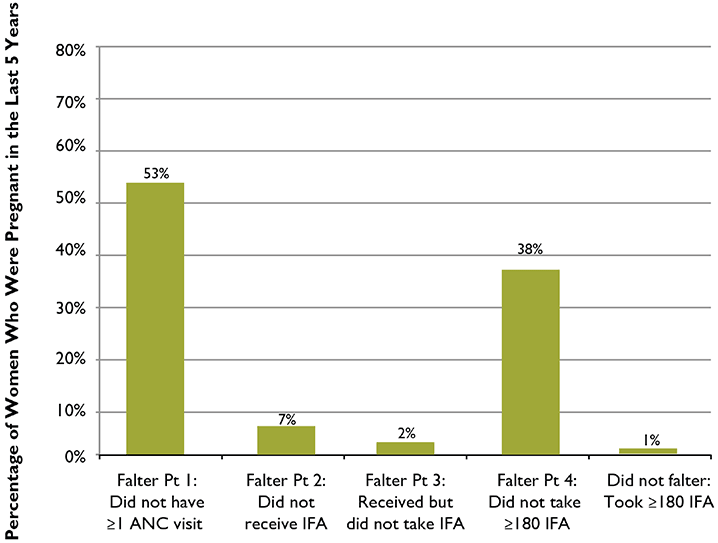
Ensuring access to quality ANC will be essential to achieving Millennium Development Goal (MDG) 5: to reduce maternal mortality and improve maternal health. Niger’s maternal mortality rate (MMR) is one of the highest in the world, at 684 maternal deaths per 100,000 live births. Although the country’s MMR has marginally declined over the past decade, the slow progress puts the country’s MMR target of 175 in 2015 virtually out of reach (INS 2010). Since the 1990s, a number of programs and policies have incorporated the promotion of maternal health. For example, Niger’s 2005–2010 Health Development Plan supported iron supplementation and assisted childbirth, among other activities. As this rapid assessment of the distribution of IFA tablets through ANC suggests, there is substantial room for continued improvement in both the supply and the demand sides of the country’s ANC program. Improving the distribution of IFA through the ANC program is an important strategy for preventing and controlling anemia in Niger, and for improving the nutrition and health status as well as the mental and physical capacity of women of reproductive age.
Footnotes
1 WHO categorizes the severity of anemia as a public health problem according to the condition’s prevalence: < 5 percent, no public health problem; 5–19.9 percent, mild; 20–39.9 percent, moderate; ≥ 40 percent, severe.
2 The DHS hemoglobin levels used to diagnose the severity of anemia in non-pregnant women differ from those specified by WHO. The DHS cutoffs for pregnant (P) and non-pregnant (NP) women in hemoglobin g/ dL are mild 10.0–10.9 (P), 10.0–11.9 (NP); moderate, 7.0–9.9 (P), 7.0–9.9 (NP); severe, < 7.0 (P), < 7.0 (NP); any, < 11.0 (P), < 12.0 (NP).
3 The NDHS asked about IFA tablets or capsules; this brief refers to all forms as “tablets.”
4 The NDHS provides a population-based, nationally representative sample of all women in Niger.
References
Attama, S., M. Seroussi, A. I. Kourguéni, H. Koché, and B. Barrèm. 1998. Enquête Démographique et de Santé, Niger, 1998. Calverton, MD: Care International Niger and Macro International.
Horton, S., and J. Ross. 2003. “The Economics of Iron Deficiency.” Food Policy 28(1):51–75.
Institut National de la Statisique (INS) [Niger]. 2010. Rapport National sur les Progrès vers l’atteinte des Objectifs du Millénaire pour le Développement. Niamey: INS.
Institut National de la Statistique (INS) [Niger] and Macro International. 2007. Enquête Démographique et de Santé et à Indicateurs Multiples du Niger, 2006. Calverton, MD: INS and Macro International.
Preziosi, P., A. Prual, P. Galan, H. Daouda, H. Boureima, and S. Hercberg. 1997. “Effect of Iron Supplementation on the Iron Status of Pregnant Women: Consequences for Newborns.” American Journal of Clinical Nutrition 66(5):1178–82.
Stoltzfus, R. J., L. Mullany, and R. E. Black. 2004. “Iron Deficiency Anemia.” In Comparative Quantification of Health Risks: Global and Regional Burden of Disease Attributable to Selected Major Risk Factors. M. Ezzati, A. D. Lopez, A. Rodgers, and C. J. L. Murray, eds. Geneva: World Health Organization.
Stoltzfus, R. J., and M. L. Dreyfuss. 1998. Guidelines for the Use of Iron Supplements to Prevent and Treat Iron Deficiency Anemia. Washington, DC: ILSI Press.
World Health Organization (WHO). 2012. Guideline: Daily Iron and Folic Acid Supplementation in Pregnant Women. Geneva, World Health Organization.